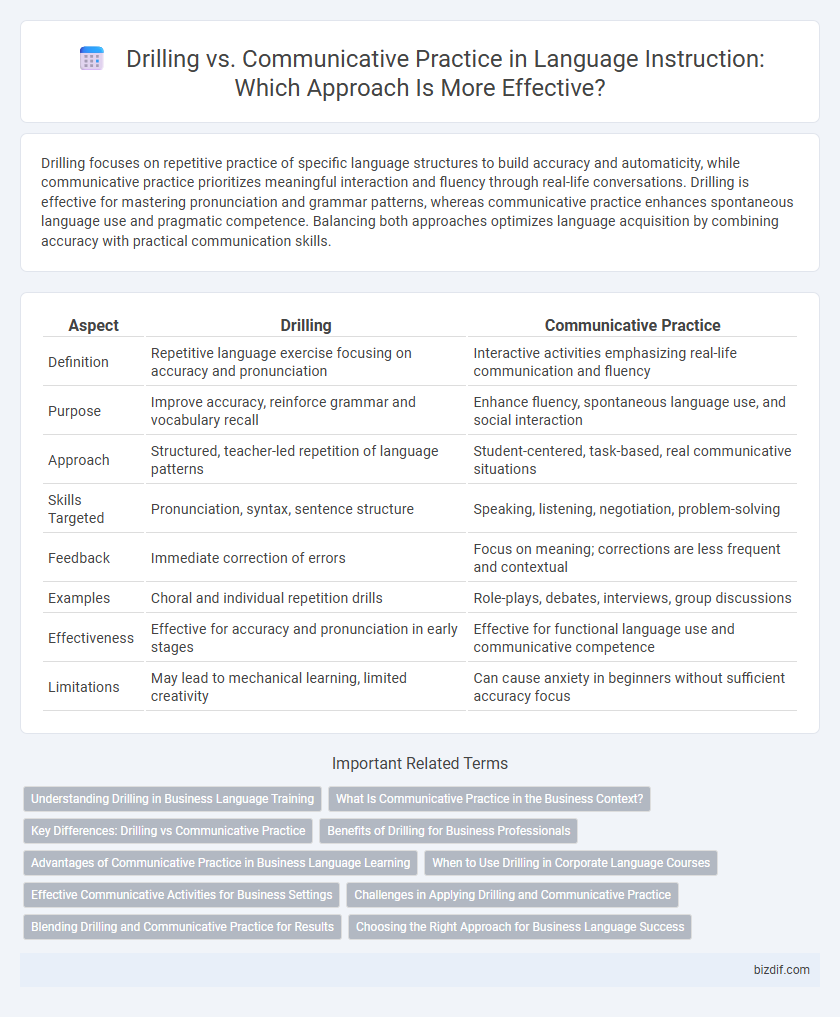Drilling focuses on repetitive practice of specific language structures to build accuracy and automaticity, while communicative practice prioritizes meaningful interaction and fluency through real-life conversations. Drilling is effective for mastering pronunciation and grammar patterns, whereas communicative practice enhances spontaneous language use and pragmatic competence. Balancing both approaches optimizes language acquisition by combining accuracy with practical communication skills.
Table of Comparison
| Aspect | Drilling | Communicative Practice |
|---|---|---|
| Definition | Repetitive language exercise focusing on accuracy and pronunciation | Interactive activities emphasizing real-life communication and fluency |
| Purpose | Improve accuracy, reinforce grammar and vocabulary recall | Enhance fluency, spontaneous language use, and social interaction |
| Approach | Structured, teacher-led repetition of language patterns | Student-centered, task-based, real communicative situations |
| Skills Targeted | Pronunciation, syntax, sentence structure | Speaking, listening, negotiation, problem-solving |
| Feedback | Immediate correction of errors | Focus on meaning; corrections are less frequent and contextual |
| Examples | Choral and individual repetition drills | Role-plays, debates, interviews, group discussions |
| Effectiveness | Effective for accuracy and pronunciation in early stages | Effective for functional language use and communicative competence |
| Limitations | May lead to mechanical learning, limited creativity | Can cause anxiety in beginners without sufficient accuracy focus |
Understanding Drilling in Business Language Training
Drilling in business language training emphasizes repetitive practice of specific phrases and vocabulary to reinforce accuracy and fluency in professional contexts. This method helps learners internalize essential business terms and standard expressions, ensuring quick recall during real-life interactions such as meetings or negotiations. By contrast, communicative practice prioritizes spontaneous dialogue, but drilling remains crucial for mastering foundational language structures in corporate communication.
What Is Communicative Practice in the Business Context?
Communicative practice in the business context emphasizes real-life interaction and meaningful exchange of information, enhancing employees' ability to use language effectively in professional settings such as meetings, negotiations, and presentations. This approach encourages spontaneous conversation and problem-solving, developing practical communication skills that go beyond repetitive drilling of vocabulary or grammar. By simulating authentic workplace scenarios, communicative practice fosters fluency, cultural understanding, and confidence crucial for successful business communication.
Key Differences: Drilling vs Communicative Practice
Drilling centers on repetitive language exercises to reinforce accurate pronunciation, grammar patterns, and vocabulary retention, emphasizing form over meaning. Communicative Practice prioritizes the use of language in real-life contexts, fostering fluency, spontaneous interaction, and meaningful exchanges among learners. The key difference lies in Drilling's structured repetition for accuracy versus Communicative Practice's emphasis on practical language use and learner engagement.
Benefits of Drilling for Business Professionals
Drilling in language instruction offers business professionals focused repetition that enhances accuracy in vocabulary and phrase usage critical for negotiations and presentations. This method reinforces confidence and fluency in specific business terminology, ensuring clarity and professionalism in communication. Consistent drilling accelerates retention and helps mitigate errors in high-stakes corporate interactions.
Advantages of Communicative Practice in Business Language Learning
Communicative practice in business language learning enhances real-world conversational skills by prioritizing meaningful interaction and context-specific vocabulary. It fosters cultural understanding and pragmatic competence, essential for effective negotiations and relationship-building in professional settings. This approach also improves fluency and confidence, enabling learners to navigate diverse business scenarios with greater ease and authenticity.
When to Use Drilling in Corporate Language Courses
Drilling is most effective in corporate language courses during the initial stages of language acquisition when employees need to internalize specific phrases, vocabulary, or pronunciation with precision. This method reinforces automatic recall and builds confidence in foundational language skills essential for professional communication. Use drilling to strengthen employee familiarity with standardized expressions, particularly in customer service, compliance, and safety-related interactions.
Effective Communicative Activities for Business Settings
Effective communicative activities in business settings prioritize authentic interactions that mimic real-life professional scenarios, fostering practical language use and fluency. Unlike drilling, which emphasizes repetitive practice of specific linguistic structures, communicative practice engages learners in problem-solving, negotiations, and presentations that enhance critical thinking and adaptability. This approach aligns with occupational language needs by integrating task-based learning tailored to industry-specific vocabulary and communication protocols.
Challenges in Applying Drilling and Communicative Practice
Drilling often faces challenges such as student anxiety and lack of contextual relevance, which can hinder natural language acquisition. Communicative practice struggles with maintaining grammatical accuracy while encouraging spontaneous interaction, often causing difficulty in balancing fluency and correctness. Both methods require careful adaptation to learner needs and classroom dynamics to maximize effectiveness and engagement.
Blending Drilling and Communicative Practice for Results
Blending drilling and communicative practice enhances language acquisition by combining accuracy and fluency development, allowing learners to internalize correct structures while engaging in meaningful interaction. Drilling reinforces grammatical patterns and pronunciation, creating a solid foundation, whereas communicative practice promotes spontaneous language use and real-life application. Integrating both methods maximizes retention and practical competence, resulting in more effective and balanced language instruction outcomes.
Choosing the Right Approach for Business Language Success
Drilling enhances accuracy and reinforces specific language patterns essential for precise business communication, while communicative practice promotes fluency and the ability to navigate real-world business interactions effectively. Selecting the right approach depends on the learners' proficiency level and business goals, with drilling suited for beginners needing structure and communicative practice for advanced learners aiming for practical application. Combining both methods strategically maximizes language retention and functional competence in professional settings.
Drilling vs Communicative practice Infographic

 bizdif.com
bizdif.com